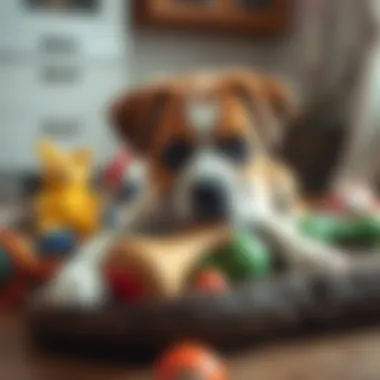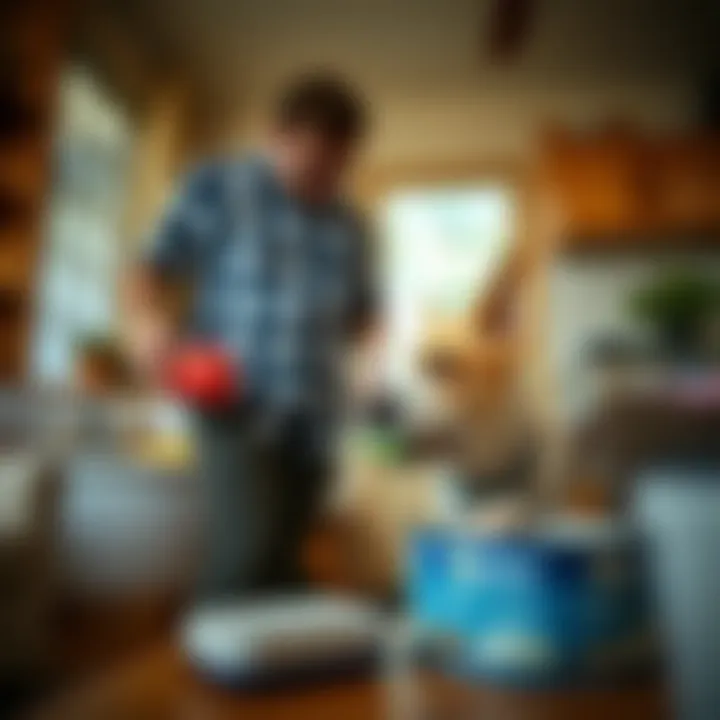Effective Strategies to Curb Your Dog's Chewing Behavior


Intro
Every dog owner knows that chewing is a natural behavior for dogs. However, excessive chewing can turn into a source of frustration. Not only can it damage furniture and belongings, but it can also signal deeper issues. Addressing your dog’s chewing habits requires understanding the motivations behind this behavior, applying effective strategies, and creating a supportive environment for proper habits to develop.
In this guide, we will explore a variety of strategies designed to lower your dog’s chewing issues. We will approach this from multiple angles, covering essentials like nutrition and training, and offering practical tips to transform your dog’s behavior into one that is not only manageable but also rewarding for both of you. The focus here is not just on stopping the behavior but on fostering a more harmonious living environment.
Pet Care Essentials
Daily Nutrition Requirements
Providing your dog with well-balanced nutrition is crucial. A poor diet might lead to chewing due to energy excess or nutrient deficiency. High-quality dog food should be rich in proteins, healthy fats, and fiber. Look for ingredients like chicken, fish, sweet potatoes, and brown rice. Ensuring you’re meeting your dog's daily nutritional needs can often reduce their urge to chew out of boredom or anxiety.
Exercise and Playtime
Exercise is a vital component of managing your dog's chewing behavior. A dog that gets regular exercise is usually less rambunctious. Aim for at least an hour of various physical activities, such as walking, fetching, or agility training. Combine these with mental stimulation—dogs enjoy puzzle toys and training sessions. When you exhaust them, they may be too tired to chew inappropriately, and instead they may curl up for a nap.
Grooming Tips
Regular grooming not only keeps your dog looking sharp, but it can also be a preventative measure against certain behaviors, including excessive chewing. A well-groomed, healthy dog is less likely to behave destructively. Brush your dog's coat regularly and keep their nails trimmed and ears clean. This fosters their overall wellbeing, contributing to a happier pup and, in turn, a more peaceful home.
Health and Wellness Check-ins
Never underestimate the importance of regular veterinary check-ups. Routine health exams help catch any health issues that could lead to chewing. If your dog suddenly starts chewing more than usual, they may be in pain or not feeling well. Parasites, dental issues or allergies can all contribute to changes in behavior. Staying on top of these health check-ups can make a world of difference in your dog's behavior—and your home’s condition.
Behavior & Training
Understanding Your Pet's Body Language
A big part of effective training involves understanding your dog's body language. Dogs communicate a lot through their posture and movements. When they seem anxious, that may lead them to chew more. For instance, if your dog’s tail is tucked or they keep looking away, they could be feeling stressed. Recognizing these signs early on helps you address their needs before they feel compelled to chew excessively.
Basic Training Techniques
Training your dog should come from a positive reinforcement perspective. Using treats and praise when your dog engages with appropriate items, rather than chewing on furniture, reinforces good behavior. Simple commands like "leave it" or "no chew" should be part of your daily training routine. Consistency is key to making these behaviors stick, so ensure that everyone in the household is on the same page regarding commands and expectations.
Behavioral Concerns & Solutions
Often, behaviors stem from boredom or anxiety. Identifying the root cause can help determine the best solution. Keep a diary of your dog’s behavior—note when and where the chewing occurs. If it’s during times of separation, consider crate training or providing a safe space with chew-safe toys. Using calming products like pheromone diffusers can also help soothe anxious dogs.
Socialization Tips
Socializing your dog can reduce anxiety and behavioral problems. Expose them to different environments, people, and other animals. This helps them feel secure in various situations, which can prevent destructive behaviors like chewing due to stress. Organizing playdates with other well-behaved dogs or visiting dog parks can benefit both of you immensely.
Pet Home Environment
Creating a Pet-friendly Space
Designing a space for your pet to thrive is crucial. Make an area where your dog feels safe and comfortable. This could include blankets, their favorite toys, or even a tuning in to soft music. The more they feel that this space is theirs, the less likely they will stray to chewing on inappropriate items.
Safety Measures and Hazards to Avoid
A well-organized room can make a world of difference. Remove any items that can be hazardous, such as electrical cords or small objects they can swallow. Make use of baby gates to restrict access to areas where they may find things to chew. Make sure their environment is safe, allowing them to explore without fear of injury.
Choosing the Right Toys and Accessories
Investing in durable toys is vital. Look for toys made specifically for chewing, like Kong toys or hard rubber. These not only satisfy your dog’s desire to chew but can also keep them mentally engaged. Keep a rotation of toys to avoid boredom—it’s like shopping at home for your pup, keeping them entertained as well as focused.
Setting Up a Comfortable Resting Area
Your pet’s sleeping area should be a sanctuary. It should provide comfort and security away from household chaos. A cozy bed, protected from noise and overactive kids, can work wonders. An area designated specifically for your dog to unwind can reduce their anxiety—which, in turn, lessens the chance of them chewing out of frustration.
Pet Health Issues
Recognizing Signs of Illness
Being attentive to your dog's health is vital. Look out for signs such as lethargy, changes in appetite, or excessive chewing. These can be red flags indicating something is wrong. If your dog seems off, it's wise to consult a veterinarian to rule out possible health concerns.
Preventative Care Measures
Preventative care helps keep both the owner and pet happy. Regular vaccinations, parasite control, and oral health checks are essential parts of this process. Taking these steps reduces the likelihood of health problems down the line, which can influence behavior, including chewing.
Common Ailments and Treatments
Familiarize yourself with common ailments that might lead to destructive behavior. Ear infections, dental disease, or allergies can cause discomfort, which may manifest as excessive chewing. Knowing these ailments helps you respond quickly to any signs your dog may present.
Emergency Preparedness
Preparedness goes a long way in ensuring your dog’s safety. Make sure you have a basic first-aid kit with necessary supplies on hand. Familiarize yourself with nearby veterinary clinics and emergency centers. Additionally, know what to do if your dog gets injured or has a sudden change in behavior, as a little knowledge can go a long way in a crisis.
By understanding the driving factors behind excessive chewing and implementing the outlined strategies, you can create a loving, healthy environment. Whether through nutrition, exercise, or behavioral training, each step strengthens your bond with your dog and helps keep your home enjoyable for all.
For further reading on pet care, you can explore resources like American Kennel Club, PetMD, and various veterinary affiliations.
Understanding Chewing in Dogs


Understanding your dog's chewing behavior is fundamental for any pet owner. This section sheds light on why dogs chew, the various reasons behind it, and how to address and manage this behavior effectively. Chewing is a natural instinct for dogs, but when it goes awry, it can lead to many issues in your household. By grasping the psychology and triggers behind chewing, you can proactively find solutions, fostering a better environment for both you and your furry friend.
The Psychology of Chewing
Chewing isn't just a method for dogs to occupy their time; it's deeply rooted in their nature. Dogs chew for several reasons, including instinctual behaviors, boredom, and a need for sensory stimulation. Just like a toddler might suck on their thumb, dogs find comfort in chewing. It releases pent-up energy and stress while offering them a way to explore the world around them.
Moreover, young pups often engage in chewing as a way of dealing with the discomfort associated with teething. Understanding this behavior in your pet can help you decide on the most appropriate ways to redirect or encourage their chewing habits.
Benefits of Comprehending Dog Chewing
- Helps you identify the root causes of destructive chewing.
- Enables you to provide suitable alternatives, reducing frustration.
- Enhances the bond between you and your pet through attentive care.
Different Types of Chewing Explained
Not all chewing is created equal; there are various types that pet owners should recognize.
- Exploratory Chewing: Pups often chew to explore their surroundings. This behavior is common in puppies who are learning and discovering new scents and textures.
- Playful Chewing: Many dogs chew as part of their play. This includes gnawing on toys or household items, which helps to promote playful behavior.
- Anxiety-Induced Chewing: Dogs experiencing stress or anxiety may chew destructively on things like furniture or shoes. This is a signal that something might be troubling them.
- Boredom Chewing: When dogs lack stimulation, they often resort to chewing as a way to entertain themselves. Providing engaging activities can mitigate this.
- Compulsive Chewing: In some cases, dogs may develop a compulsive chewing habit. This requires attention and possibly professional guidance.
By understanding these categories, you can take necessary steps to address chewing behavior effectively.
Identifying Triggers for Chewing
Understanding the triggers for your dog’s chewing is crucial. Some common factors include:
- Age and Developmental Stage: Puppies have different chewing needs compared to adult dogs. Recognizing the developmental stage can lead to more effective strategies.
- Change in Environment: A new home, family member, or routine can unsettle dogs and lead them to chew out of frustration or anxiety.
- Lack of Exercise: Insufficient physical activity can result in excess energy, often finding an outlet through chewing.
- Separation Anxiety: Dogs can show signs of stress when left alone, resulting in unwanted chewing to soothe their anxiety.
Identifying these triggers allows you to intervene before the behavior escalates, making it easier to protect your valuables and maintain a peaceful home.
“Understanding your dog's chewing habits can create a more harmonious living situation for both you and your pet.”
In summary, gaining a deeper understanding of why dogs chew, recognizing the various types of chewing, and identifying the specific triggers can provide you with a strong foundation to tackle excessive chewing. This knowledge paves the way for effective prevention and correction strategies, ultimately leading to a more balanced coexistence with your canine companion.
Common Causes of Chewing Behavior
Understanding the root causes of your dog’s chewing tendencies is crucial for any pet owner. Without grasping these underlying aspects, tackling the behavior could prove largely ineffective. Chewing can stem from a variety of reasons, and each can require a unique approach. Recognizing these causes helps owners pinpoint specific strategies that cater to their individual dog’s needs. This can ultimately lead to a happier and healthier relationship between the pooch and its owner.
Teething in Puppies
Puppies are like little tornadoes; they come into the world with sharp teeth and a knack for wreaking havoc. During their teething phase, typically between three to six months of age, they’re likely to chew on anything they can get their paws on. This chewing is natural and instinctual as it helps them alleviate discomfort from their developing teeth.
Signs Your Puppy is Teething:
- Excessive biting or chewing on toys, furniture, or human hands.
- Drooling more than usual.
- Whining or appearing restless.
To prevent damage to household items, provide appropriate chew toys designed for teething. Rubber toys or frozen cloths can soothe their gums while ensuring your living space remains intact.
Boredom and Lack of Stimulation
Think of a dog’s mind like a sponge; it thrives on learning and stimulation. A bored dog often resorts to undesirable behaviors to entertain itself, chewing being one of the most common outlets. Dogs need a mental workout just as much as they need physical exercise. Without sufficient outlets for their energy—especially for intelligent breeds—they can easily resort to destructive chewing.
Ways to Combat Boredom:
- Engage in daily walks and play sessions,
- Rotate their toys regularly to maintain novelty,
- Teach them new tricks or commands.
Interactive puzzles that dispense treats can also keep your dog's brain engaged and curb unsightly chewing behaviors.
Separation Anxiety Explained
Dogs are social creatures. Being separated from their owners can lead to feelings of anxiety, making them act out in ways that may include chewing. This behavioral pattern isn’t merely a sign of mischief; it’s a cry for help. Understanding this element of canine behavior is key to forming a comfortable environment for your dog and reducing these unfortunate moments.
Signs of separation anxiety include:
- Destructive chewing, especially around door frames or furniture.
- Barking, whining, or howling when left alone.
- Excessive drooling or pacing.
To alleviate separation anxiety, consider gradually training your pet to feel comfortable alone, starting with short intervals before progressing to longer durations.
Stress Factors Affecting Dogs
Just like humans, dogs can experience stress due to a variety of factors—changes in their environment, loud noises, or even a new family member can unsettle them. Chewing is a common coping mechanism as they try to soothe their frayed nerves. Keeping an eye on environmental triggers can help preempt stress-induced chewing.
Common Stressors in a Dog's Life:
- Loud noises like fireworks or thunder.
- Changes in routine or household dynamics.
- Travel or moving to a new home.
Creating a calming space for your dog equipped with soft bedding and familiar toys can assist in reducing stress. In some cases, seeking advice from a veterinarian or a canine behaviorist may be necessary if the problem persists.
"Identifying the underlying causes of your dog's chewing behaviors is the first step to restoring harmony in your home."
Understanding these common causes of chewing behavior can help pet owners tailor their approach, fostering a solution that meets their canine companions' needs while preserving household items.
Evaluating Your Dog's Chewing Habits
Understanding your dog's chewing habits is not just a trivial pursuit; it is a crucial step toward addressing the root of the problem. Many pet owners may jump straight to deterrents or punishment, but successful management comes from a more nuanced appreciation of when, how, and what their dog chews. Evaluating these habits allows for tailored interventions that reflect your dog's unique needs and personality. This proactive approach can lead to better outcomes—reducing frustration for both the pet and the owner.


When assessing chewing behavior, consider the following elements:
- Recognizing the context in which chewing occurs.
- Monitoring what items are frequently chewed.
- Understanding your dog's emotional state during these episodes.
The benefits of evaluation are manifold. Not only does it help pet owners develop a clearer picture of the underlying causes of chewing, but it also enables them to implement strategies that are more likely to resonate with their dog's behavior patterns.
Setting Up a Chewing Diary
To embark on a systematic evaluation, one effective method is to create a chewing diary. This doesn't have to be anything fancy—just a simple notebook or digital document where you jot down observations. Start by recording specific details:
- Date and Time: Note when chewing incidents occur. Is it typically during the day, at night, or when you leave the house?
- Location: Where does your dog usually chew? Identifying specific areas can highlight patterns.
- Items Chewed: Make a list of the objects that fall prey to your dog's teeth—whether it's furniture, shoes, or toys. This can provide insights into preferences and potential triggers.
- Duration: Take note of how long these chewing sessions last. Is your dog a quick chewer, or do they take their time?
- Behavioral Cues: Document your dog's state prior to and during chewing. Are they anxious, bored, or perhaps excited?
Regular entries can be invaluable for both you and a potential trainer or behaviorist down the line.
Identifying Patterns in Chewing
Once you've established your chewing diary, the next step is identifying patterns in your dog's chewing behavior. You might find, for example, that your dog is more likely to chew when left alone, or that specific events—like family visits or a new gadget in the home—trigger this behavior. Identifying these trends can guide your next steps.
Look for factors such as:
- Time of Day: Does your dog chew more during certain hours?
- Environmental Changes: Have you recently moved, changed routines, or introduced new family members?
- Emotional Responses: Are there specific triggers that seem to correlate with episodes of chewing?
By recognizing these patterns, pet owners can devise targeted strategies to curb inappropriate chewing. For example, if boredom is a common factor, enriching your dog's environment with interactive toys could make all the difference.
"A dog's behavior tells a story. Your job is to read between the lines."
This deep dive into evaluating chewing habits is essential for navigating your dog's behavior effectively. It sets a solid foundation for developing a tailored plan that addresses not just the symptom but the core issues at play.
Strategies for Prevention and Correction
In tackling your dog's chewing behavior, prevention and correction play crucial roles. Taking proactive measures means creating a home environment less conducive to undesirable chewing. When a dog has appropriate outlets for their chewing instincts, the chances of them going for furniture, shoes, or other household items drop significantly. This section delves into practical strategies that can correct chewing behaviors before they become ingrained habits.
Providing Appropriate Chew Toys
One of the most effective ways to redirect your dog's chewing habits is through the provision of suitable chew toys. Dogs need to chew; it's ingrained in their instincts. Choosing the right toys is paramount:
- Durability: Select toys made from tough materials such as rubber or nylon. These last longer and withstand rigorous chewing.
- Variety: Just like humans can get bored with the same snacks, dogs can easily tire of their toys. Rotate toys regularly to keep your dog’s interest piqued.
- Size Matters: Ensure the toys are appropriate for the dog's size. A Great Dane won’t find joy in a toy meant for a Chihuahua.
Investing in quality toys not only distracts your dog from chewing on household items but also encourages healthy chewing, which can aid in oral health. Furthermore, interactive toys, like puzzle toys, can stimulate their brains, helping to reduce boredom-related chewing.
Creating a Safe Chewing Environment
Setting the stage for a chewing-friendly environment is equally important. A safe chewing area allows your dog to express this natural behavior without facing dire consequences. Here’s how you can achieve this:
- Dog-Proof Your Space: Remove or secure items that could be harmful when chewed, like electrical cords or toxic plants.
- Designate a Chewing Zone: Create a specific area with chew toys and blankets where your dog can feel comfortable and enjoy their chewing in peace.
- Positive Association: Use treats or praise when your dog chooses a toy over a forbidden item. This encourages them to associate positive experiences with approved chewing options.
This environment won't just provide a safe space; it fosters a sense of security and well-being in your pet, allowing them to enjoy their chewing instincts in a controlled manner.
Introducing Deterrents Wisely
Lastly, deterrents can be a valuable assistant when it comes to discouraging inappropriate chewing. It's essential to use them wisely, as some methods might scare or distress your dog. Here are approaches to consider:
- Bitter Sprays: Use dog-safe bitter sprays on furniture. The unpleasant taste can help dogs associate chewing on furniture with a negative experience.
- Consistency is Key: If you catch your dog in the act of chewing something inappropriate, redirect them gently to an acceptable chew toy and reward them for making the right choice.
- Training Collars: In extreme cases, consult with a professional to explore training collars that can inhibit unwanted behaviors through gentle corrections.
Introducing these deterrents helps create guidelines for acceptable chewing behavior while ensuring that methods are humane and considerate of your dog's well-being. Balance is crucial; implementing too many deterrents can lead to anxiety or stress.
Engaging thoughtfully with your dog’s natural instincts—by providing, designing, and deterring—lays down the foundation for an effective prevention and correction strategy. By shifting their chewing focus toward designated items, one cultivates not just a chewing restraint but a stronger bond with the pet.
Training Techniques to Address Chewing
Training techniques play a crucial role in curbing a dog’s chewing behavior. They not only help to minimize unwanted chewing but also strengthen the bond between you and your pet. By implementing proper training, pet owners can guide their dogs’ instincts and redirect their energy in constructive ways. Understanding the specific training strategies available can lead to significant improvements in your dog’s behavior, fostering a peaceful coexistence in your home for both pets and their people.
Positive Reinforcement Methods
Positive reinforcement is about rewarding desirable behaviors rather than punishing the unwanted ones. For example, when your dog chooses a chew toy rather than your favorite pair of shoes, showering them with praise, or offering a treat, reinforces that good choice. This method taps into a dog’s desire for approval and can be very effective in shaping their habits.
"Reward the behavior you want to see more often." This mantra is the essence of positive reinforcement. When using this strategy, it’s important to be immediate with rewards so your dog can make the connection between their action and the reward clear. Start by keeping treats handy. You could consider using small pieces of kibble or specially made dog treats.
In time, dogs often start to favor the chew items you provide simply because they associate them with positive experiences, leading to better chewing habits and fewer furniture casualties.
Consistency in Training Sessions
Consistency cannot be overstated. If you’re trying to correct a chewing problem, every family member needs to be on the same page. If one person allows the dog to chew on the couch, while another reprimands them for it, the dog will become confused. Establishing clear, consistent rules for all household members ensures that your dog gets the message loud and clear.
Setting aside regular training sessions in a distraction-free environment can also enhance learning. Short, frequent sessions tend to be more effective than longer ones. Aim for about 5 to 10 minutes per session, sprinkling them throughout the day. This format keeps your dog engaged and less likely to lose interest or focus. When the entire household commits to consistent training, it can lead to faster results and helps establish a routine that your dog can rely on.
Utilizing Commands and Cues
Introducing commands and cues is essential in directing your dog’s behavior. Basic commands like "leave it" or "drop it" can be invaluable when you catch your dog in the act of chewing something they shouldn’t. Teaching these commands helps empower you as the owner to intervene effectively.
Once your dog reliably responds to these commands, it becomes easier to redirect their attention to appropriate objects. Pair these cues with rewarding outcomes – for instance, when your dog responds positively to a "leave it" command, reward them with a preferred chew toy. This practice not only reinforces proper behavior but also instills a level of discipline that helps your dog understand the boundaries.
Assessing the Effectiveness of Your Approach


Assessing the effectiveness of your strategies for curb your dog's chewing behavior is a crucial part of the process. Understanding how well your methods are working enables you to refine your approach and enhance the overall harmony in your home. Every dog is unique, and their responses to various techniques can differ significantly. Thus, a tailored assessment helps identify what truly resonates with your furry friend and what falls flat. It is not just about stopping the chewing; rather, it's about nurturing a well-behaved companion who feels secure and understood.
Monitoring Progress Over Time
To effectively monitor progress, it's essential to establish a baseline. Start by taking notes on the frequency, duration, and types of items your dog tends to chew. Keeping a simple record can help you see patterns. For instance, a dog might chew more when left alone or during specific times of the day. After implementing your strategies, revisit this diary to note any changes. Consistency is key; daily observations will shed light on improvements or ongoing issues. Evaluate the effectiveness of chew toys or deterrents you’ve introduced and reassess your overall approach based on these findings.
"Consistency in observation and recording helps uncover the true influence of your interventions."
Remember, a drop in chewing incidents is a positive sign. However, it's not only about numbers. Pay attention to your dog's demeanor. Are they calmer? More content? Proceed with troubleshooting if you sense something is amiss, regardless of what the numbers show.
Adjusting Strategies as Required
No strategy is cast in stone. Sometimes, what worked for a week might not yield the same results after a month. As time passes, your dog may adapt to certain rules, and their needs might change too. It’s vital to be flexible and adjust your strategies when necessary.
Here are several points to consider for adapting your approach:
- Evaluate Environment: If your dog's surroundings change, such as new family members, moving furniture, or new pets, it could lead to alterations in their chewing habits. Adjust your strategies accordingly.
- Alter Chew Toys: If your dog seems bored with the chew toys, look for options that stimulate and capture their interest – variety is vital.
- Innovate Deterrents: If you’ve used a particular deterrent and it’s no longer effective, consider switching to a different product or method. Always ensure any deterrent is humane and safe for your pet.
- Seek Feedback: Sometimes talking to fellow pet owners or trainers can provide fresh insight into your dog's chewing behavior. They might suggest techniques you haven’t considered.
Continuously adapting your strategies ensures you stay one step ahead of your dog’s evolving behavior. Observing closely not only nurtures a stronger bond with your pet but also leads you to find the best solutions that keep your home peaceful and your belongings intact.
When to Seek Professional Help
Understanding when to engage a professional can be pivotal in addressing your dog’s chewing behavior effectively. It may be tempting to tackle the issue solo, especially with the abundant advice available online, but sometimes the situation calls for expertise.
Professional help can bring an objective perspective to the table. A trainer or a behaviorist will not only decipher what you might oversee but can also offer tailored guidance, accelerating your dog's progress. For instance, if you’ve been battling excessive chewing without any sign of improvement, it might be time to seek that extra layer of expertise.
Recognizing the Signs of Severe Chewing
Recognizing severe chewing behavior requires keen observation. Certain indicators suggest the problem has escalated beyond typical puppy antics:
- Destructive Patterns: Are shoes and furniture suddenly in pieces? Chewing that results in significant damage is a strong sign your pooch needs professional intervention.
- Injuries: Has your dog experienced cuts or dental issues from chewing inappropriate items? If so, it’s a glaring red flag that requires a vet or trainer’s insights.
- Escalation in Anxiety: If chewing flips from being an occasional habit to a compulsive behavior—especially during stress, it warrants a closer look. An anxiety-driven dog may also display other signs, like pacing or whining.
- Health Issues: If you notice that the chewing isn't improving, consider whether there’s an underlying health problem. Digestive troubles from eating non-food items can occur and must be dealt with immediately.
Working with a Professional Trainer
Engaging a professional trainer can be a game changer. They offer skill sets built on experience, making them invaluable resources. A few key points for considering this step:
- Individualized Training Plans: Trainers can customize a program based on your dog’s specific needs. This sort of tailored approach often yields faster success compared to generic advice.
- Behavior Modification Techniques: They employ effective methods to alter your dog's view on chewing. This is particularly vital when stress or anxiety underlines their behavior.
- Maintaining Accountability: Regular sessions mean you'll have someone guiding you every step of the way, encouraging consistency and teaching you how to reinforce good habits at home.
- Understanding Dog Psychology: Trainers draw on a deep well of knowledge concerning canine behavior. They can help bridge the gap between you and your pet, explaining why certain tactics work or don’t work.
The decision to hire a professional should not be viewed as a failure but as an important step towards a balanced, harmonious home. Recognizing the limits of your capacity in training your dog is commendable.
Seeking professional advice can turn a frustrating challenge into an opportunity for positive growth, enhancing the bond between you and your furry friend.
By acknowledging when to reach out for assistance, you're taking proactive steps to address the situation head-on, creating a calmer living environment for both you and your dog.
Potential Hazards of Chewing
Understanding the potential hazards of chewing is crucial for any dog owner who wishes to maintain a safe environment for both their pets and themselves. Chewing is a natural behavior for dogs, but several risks come with it. From safety hazards to health concerns, recognizing these dangers can help guide owners toward approaches and solutions that promote safer chewing habits.
Safety Concerns with Chewed Items
When dogs chew on inappropriate items, dangerous situations may arise. Household objects that are not designed for chewing often pose significant risks. Household appliances, electrical cords, and even shoes can become targets for a dog's chewing impulses. Here are some notable safety concerns:
- Choking Hazards: Small items like socks or food packaging can easily lodge in a dog's throat, leading to choking.
- Intestinal Blockages: If dogs ingest foreign objects, it can cause blockages in their digestive systems, requiring surgical intervention in severe cases.
- Sharp Objects: Items like broken glass or metal that may come from items being chewed can injure a dog's mouth or throat.
"It's essential to see your dog as a curious explorer; managing their environment helps detour them from unsafe habits."
Knowing what items are within reach can help you minimize safety risks. Rotating dog toys and providing dedicated chew items can help steer the focus away from dangerous objects. Consider dog-proofing your home by loose ie separating items that should not be chewed from their reach.
Understanding Toxic Materials
Certain materials can be hazardous if ingested by dogs, often leading to severe health issues. It's vital for dog owners to be aware of these toxic substances. Common items and their associated risks include:
- Household Plants: Many plants, like lilies and azaleas, can be toxic when chewed on or ingested. Pet owners should familiarize themselves with which plants are harmful.
- Cleaning Supplies: Oftentimes, cleaning agents can have appealing smells to dogs. Products containing bleach, ammonia, or other harsh chemicals can lead to poisoning if chewed or ingested.
- Certain Foods: Foods like chocolate, grapes, and onions are known to be toxic for dogs. It's vital to keep these items well out of reach to prevent accidental ingestion.
It's advisable for pet owners to seek immediate veterinary assistance if they suspect their dog has ingested any toxic material. Keeping a list of common toxic substances around the house can be a helpful reminder for all household members.
End
When it comes to addressing your dog's chewing behavior, understanding the broader implications of this issue is crucial. Recognizing that chewing isn't solely about mischief or rebellion, but often a communication of needs or stressors, can lead to more effective long-term strategies. This article has explored various facets, from the roots of chewing behaviors to the comprehensive methods one can employ to curtail this habit.
A key takeaway is the balance between understanding and action. Owners should aim to recognize the underlying causes of chewing, be it boredom, anxiety, or a natural instinct, and then implement tailored strategies to mitigate those causes. The importance of providing proper chew toys and establishing a safe environment should not be understated.
Furthermore, it’s paramount to monitor progress and adjust strategies as required. A one-size-fits-all approach rarely works in the realm of dog training; flexibility and awareness are key ingredients for success. Moreover, if you observe significant behavioral issues, seeking professional assistance can be a wise and beneficial step for both you and your pet.
Investing time and effort into correcting chewing behavior not only fosters a safer environment but also enhances the bond between pet and owner. Ultimately, it is about creating a harmonious living situation where both human and canine can coexist happily.
Recap of Key Points
In summary, revisiting the core elements we discussed:
- Understanding Chewing: It's essential to grasp why dogs chew in the first place. This can inform your approach and help you meet their needs more effectively.
- Identifying Causes: From teething in puppies to separation anxiety, recognizing motives is a cornerstone in tackling chewing habits.
- Prevention and Correction: This includes providing appropriate toys, creating safe spaces, and using deterrents properly.
- Training Techniques: Utilizing positive reinforcement and being consistent is vital for successful training.
- Monitoring Effectiveness: Tracking progress allows for necessary adjustments and shapes effective strategies.
- Professional Help: In cases of extreme chewing habits, getting help from a professional can be a dealbreaker.
These essential components when combined can lead to a significant reduction, if not a complete cessation, of undesirable chewing behavior.
Final Thoughts on Addressing Chewing Behavior
The journey to curb excessive chewing isn’t necessarily a sprint; it requires patience and diligence. Each dog is as unique as their owner, and thus, understanding your pet's individual needs and triggers is crucial in this process. By fostering an environment that acknowledges the reasons behind chewing and addresses them accordingly, pet owners can create a more comfortable atmosphere for both parties.
Continuing to adapt your approaches based on observed behavior and results will keep the process dynamic and effective. As you work through the methods outlined in this article, remember that the goal is not just to stop unwanted chewing, but to build a deeper understanding between you and your canine friend.
This enhanced relationship fosters a sense of security for your pet, allowing them to thrive in a nurturing and thoughtful environment.







